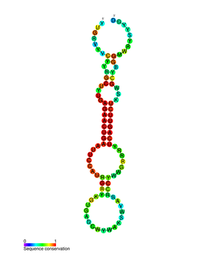miR-146
| miR-146 | |
|---|---|
 Conserved secondary structure of miR-146 microRNA precursor | |
| Identifiers | |
| Symbol | miR-146 |
| Alt. Symbols | MIR146 |
| Rfam | RF00691 |
| miRBase | MI0000477 |
| miRBase family | MIPF0000103 |
| NCBI Gene | 406938 |
| HGNC | 31533 |
| OMIM | 610566 |
| RefSeq | NR_029897 |
| Other data | |
| RNA type | miRNA |
| Domain(s) | Mammalia |
| GO | 0035195 |
| SO | 0001244 |
| Locus | Chr. 5 q34 |
| PDB structures | PDBe |
miR-146 is a family of microRNA precursors found in mammals, including humans. The ~22 nucleotide mature miRNA sequence is excised from the precursor hairpin by the enzyme Dicer.[1] This sequence then associates with RISC which effects RNA interference.[2]
miR-146 is primarily involved in the regulation of inflammation[3] and other process that function in the innate immune system.[4] Loss of functional miR-146 (and mir-145) could predispose an individual to suffer from chromosome 5q deletion syndrome.[5] miR-146 has also been reported to be highly upregulated in osteoarthritis cartilage, and could be involved in its pathogenesis.[6] mir-146 expression is associated with survival in triple negative breast cancer.[7]
Function
[edit]miR-146 is thought to be a mediator of inflammation along with another microRNA, mir-155. The expression of miR-146 is upregulated by inflammatory factors such as interleukin 1 and tumor necrosis factor-alpha.[8] miR-146 dysregulates a number of targets which are mostly involved in toll-like receptor pathways that bring about a cytokine response as part of the innate immune system.[4][8] miR-146 operates in a feedback system or "negative regulatory loop"[9] to finely tune inflammatory responses.[5]
Applications
[edit]miR-146 could be used as a biomarker for sepsis.[10] In addition it was found to be absent from the exosomes of prion infected cells suggesting it could be used as a biomarker for prion infection.[11] miR-146a could be targeted therapeutically as its depletion has implication in the hyperactive response to infection.[12]
References
[edit]- ^ Ambros V (Dec 2001). "microRNAs: tiny regulators with great potential". Cell. 107 (7): 823–6. doi:10.1016/S0092-8674(01)00616-X. PMID 11779458. S2CID 14574186.
- ^ Gregory RI, Chendrimada TP, Cooch N, Shiekhattar R (Nov 2005). "Human RISC couples microRNA biogenesis and posttranscriptional gene silencing". Cell. 123 (4): 631–40. doi:10.1016/j.cell.2005.10.022. PMID 16271387. S2CID 16973870.
- ^ Baechle JJ, Chen N, Winer DA (2023). "Chronic inflammation and the hallmarks of aging". Molecular Metabolism. 74: 101755. doi:10.1016/j.molmet.2023.101755. PMC 10359950. PMID 37329949.
- ^ a b Sonkoly E, Ståhle M, Pivarcsi A (Apr 2008). "MicroRNAs and immunity: novel players in the regulation of normal immune function and inflammation". Seminars in Cancer Biology. 18 (2): 131–40. doi:10.1016/j.semcancer.2008.01.005. PMID 18291670.
- ^ a b Quinn SR, O'Neill LA (Jul 2011). "A trio of microRNAs that control Toll-like receptor signalling". International Immunology. 23 (7): 421–5. doi:10.1093/intimm/dxr034. PMID 21652514.
- ^ Yamasaki K, Nakasa T, Miyaki S, Ishikawa M, Deie M, Adachi N, Yasunaga Y, Asahara H, Ochi M (Apr 2009). "Expression of MicroRNA-146a in osteoarthritis cartilage". Arthritis and Rheumatism. 60 (4): 1035–41. doi:10.1002/art.24404. PMC 2670476. PMID 19333945.
- ^ Lánczky A, Nagy Á, Bottai G, Munkácsy G, Szabó A, Santarpia L, Győrffy B (2016-12-01). "miRpower: a web-tool to validate survival-associated miRNAs utilizing expression data from 2178 breast cancer patients". Breast Cancer Research and Treatment. 160 (3): 439–446. doi:10.1007/s10549-016-4013-7. ISSN 1573-7217. PMID 27744485. S2CID 11165696.
- ^ a b Sheedy FJ, O'Neill LA (Dec 2008). "Adding fuel to fire: microRNAs as a new class of mediators of inflammation". Annals of the Rheumatic Diseases. 67 (Suppl 3): iii50-5. doi:10.1136/ard.2008.100289. PMID 19022814. S2CID 20802154.
- ^ Ma X, Becker Buscaglia LE, Barker JR, Li Y (Jun 2011). "MicroRNAs in NF-kappaB signaling". Journal of Molecular Cell Biology. 3 (3): 159–66. doi:10.1093/jmcb/mjr007. PMC 3104013. PMID 21502305.
- ^ Gîză DE, Vasilescu C (Sep–Oct 2010). "[MicroRNA's role in sepsis and endotoxin tolerance. More players on the stage]". Chirurgia (Bucur.). 105 (5): 625–30. PMID 21141085.
- ^ Bellingham SA, Coleman BM, Hill AF (Nov 2012). "Small RNA deep sequencing reveals a distinct miRNA signature released in exosomes from prion-infected neuronal cells". Nucleic Acids Research. 40 (21): 10937–49. doi:10.1093/nar/gks832. PMC 3505968. PMID 22965126.
- ^ O'Connell RM, Rao DS, Baltimore D (2012). "microRNA regulation of inflammatory responses". Annual Review of Immunology. 30: 295–312. doi:10.1146/annurev-immunol-020711-075013. PMID 22224773.
Further reading
[edit]- Okada H, Kohanbash G, Lotze MT (Aug 2010). "MicroRNAs in immune regulation--opportunities for cancer immunotherapy". The International Journal of Biochemistry & Cell Biology. 42 (8): 1256–61. doi:10.1016/j.biocel.2010.02.002. PMC 2889234. PMID 20144731.
- Jädersten M, Hellström-Lindberg E (May 2010). "New clues to the molecular pathogenesis of myelodysplastic syndromes". Experimental Cell Research. 316 (8): 1390–6. doi:10.1016/j.yexcr.2010.02.043. PMID 20211165.
- Chan EK, Ceribelli A, Satoh M (Apr 2013). "MicroRNA-146a in autoimmunity and innate immune responses". Annals of the Rheumatic Diseases. 72 (Suppl 2): ii90-5. doi:10.1136/annrheumdis-2012-202203. PMC 7664460. PMID 23253933. S2CID 35063994.
See also
[edit]External links
[edit]
